
Differences Between Silicon Carbide Crucibles and Graphite Crucibles
Silicon carbide crucibles and graphite crucibles are commonly used high-temperature containers in laboratories and industrial settings. They exhibit significant differences in material types, lifespan, pricing, applicable ranges, and performance. Here's a detailed comparison to aid in selecting the most suitable crucible for specific needs:
1. Material Types:
- Silicon Carbide Crucibles: Typically made from silicon carbide materials, these crucibles offer excellent high-temperature resistance and corrosion resistance. They are well-suited for processes such as sintering, heat treatment, and crystal growth of metals and ceramics.
- Graphite Crucibles: Primarily crafted from natural flake graphite, also known as graphite clay crucibles, they find applications in the heat treatment and crystal growth of both metallic and non-metallic materials.
2. Lifespan:
- Graphite Crucibles: Relative to silicon carbide crucibles, graphite crucibles have a longer lifespan, typically ranging from three to five times that of silicon carbide crucibles.
3. Pricing:
- Silicon Carbide Crucibles: Due to manufacturing processes and material costs, silicon carbide crucibles are generally priced higher compared to graphite crucibles. However, in certain applications, their superior performance may justify the cost difference.
4. Applicable Ranges:
- Silicon Carbide Crucibles: In addition to being suitable for processing metals and ceramics, silicon carbide crucibles are also applicable in the fields of electronics and optoelectronics.
- Graphite Crucibles: Suitable for a wide range of metallic and non-metallic materials in heat treatment and crystal growth processes.
5. Performance Differences:
- Graphite Crucibles: With a density of approximately 1.3 kg/cm², an inner and outer temperature difference of around 35 degrees, and relatively poor resistance to acid and alkali corrosion, graphite crucibles may not provide energy savings comparable to silicon carbide crucibles.
- Silicon Carbide Crucibles: With a density ranging from 1.7 to 26 kg/mm², an inner and outer temperature difference of 2-5 degrees, and good resistance to acid and alkali corrosion, silicon carbide crucibles offer energy savings of around 50%.
Conclusion:
When choosing between silicon carbide and graphite crucibles, researchers should consider experimental requirements, budget constraints, and the desired performance. Silicon carbide crucibles excel in high-temperature and corrosive environments, while graphite crucibles offer advantages in terms of cost-effectiveness and broad applicability. By understanding these differences, researchers can make informed decisions to ensure optimal results in their experiments.
Post time: Jan-29-2024
